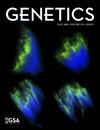MAB-5/Hox regulates the Q neuroblast transcriptome, including cwn-1/Wnt, to mediate posterior migration in Caenorhabditis elegans.
IF 5.1
3区 生物学
引用次数: 0
Abstract
Neurogenesis involves the precisely coordinated action of genetic programs controlling large-scale neuronal fate specification down to terminal events of neuronal differentiation. The Q neuroblasts in Caenorhabditis elegans, QL on the left and QR on the right, divide, differentiate, and migrate in a similar pattern to produce three neurons each. However, QL on the left migrates posteriorly, and QR on the right migrates anteriorly. The MAB-5/Hox transcription factor is necessary and sufficient for posterior Q lineage migration and is normally expressed only in the QL lineage. To define genes controlled by MAB-5 in the Q cells, fluorescence-activated cell sorting was utilized to isolate populations of Q cells at a time in early L1 larvae when MAB-5 first becomes active. Sorted Q cells from wild-type, mab-5 loss-of-function (lof), and mab-5 gain-of-function (gof) mutants were subject to RNA-seq and differential expression analysis. Genes enriched in Q cells included those involved in cell division, DNA replication, and DNA repair, consist with the neuroblast stem cell identity of the Q cells at this stage. Genes affected by mab-5 included those involved in neurogenesis, neural development, and interaction with the extracellular matrix. cwn-1, which encodes a Wnt signaling molecule, showed a paired response to mab-5 in the Q cells: cwn-1 expression was reduced in mab-5(lof) and increased in mab-5(gof), suggesting that MAB-5 is required for cwn-1 expression in Q cells. MAB-5 is required to prevent anterior migration of the Q lineage while it transcriptionally reprograms the Q lineage for posterior migration. Functional genetic analysis revealed that CWN-1 is required downstream of MAB-5 to inhibit anterior migration of the QL lineage, likely in parallel to EGL-20/Wnt in a noncanonical Wnt pathway. In sum, work here describes a Q cell transcriptome, and a set of genes regulated by MAB-5 in the QL lineage. One of these genes, cwn-1, acts downstream of mab-5 in QL migration, indicating that this gene set includes other genes utilized by MAB-5 to facilitate posterior neuroblast migration.MAB-5/Hox调节Q神经母细胞转录组,包括cwn-1/Wnt,以介导秀丽隐杆线虫的后向迁移。
神经发生涉及基因程序的精确协调作用,这些程序控制着大范围神经元命运的规范,直至神经元分化的终端事件。秀丽隐杆线虫的 Q 神经母细胞(左侧为 QL,右侧为 QR)以相似的模式分裂、分化和迁移,各自产生三个神经元。不过,左侧的 QL 向后迁移,而右侧的 QR 则向前方迁移。MAB-5/Hox 转录因子是 Q 系向后迁移的必要和充分条件,通常只在 QL 系中表达。为了确定 Q 细胞中受 MAB-5 控制的基因,我们利用荧光激活细胞分选技术,在 L1 幼虫早期 MAB-5 开始活跃时分离 Q 细胞群。对野生型、mab-5 功能缺失(lof)和 mab-5 功能增益(gof)突变体的 Q 细胞进行了 RNA 序列和差异表达分析。Q细胞中富集的基因包括参与细胞分裂、DNA复制和DNA修复的基因,这与此阶段Q细胞的神经母细胞干细胞特征一致。编码Wnt信号分子的cwn-1在Q细胞中显示出与mab-5成对的反应:cwn-1在mab-5(lof)中表达减少,而在mab-5(gof)中表达增加,这表明MAB-5对Q细胞中cwn-1的表达是必需的。MAB-5是防止Q系向前方迁移所必需的,同时它还能转录重编程Q系向后方迁移。功能基因分析表明,CWN-1需要在MAB-5的下游抑制QL系的前向迁移,很可能与EGL-20/Wnt并行于非经典的Wnt通路。总之,本文描述了 Q 细胞转录组和 QL 系中受 MAB-5 调控的一组基因。其中一个基因cwn-1在QL迁移过程中作用于mab-5的下游,这表明该基因组包括MAB-5用于促进后部神经母细胞迁移的其他基因。
本文章由计算机程序翻译,如有差异,请以英文原文为准。
求助全文
约1分钟内获得全文
求助全文
来源期刊

Genetics
生物-遗传学
CiteScore
6.20
自引率
6.10%
发文量
177
期刊介绍:
GENETICS is published by the Genetics Society of America, a scholarly society that seeks to deepen our understanding of the living world by advancing our understanding of genetics. Since 1916, GENETICS has published high-quality, original research presenting novel findings bearing on genetics and genomics. The journal publishes empirical studies of organisms ranging from microbes to humans, as well as theoretical work.
While it has an illustrious history, GENETICS has changed along with the communities it serves: it is not your mentor''s journal.
The editors make decisions quickly – in around 30 days – without sacrificing the excellence and scholarship for which the journal has long been known. GENETICS is a peer reviewed, peer-edited journal, with an international reach and increasing visibility and impact. All editorial decisions are made through collaboration of at least two editors who are practicing scientists.
GENETICS is constantly innovating: expanded types of content include Reviews, Commentary (current issues of interest to geneticists), Perspectives (historical), Primers (to introduce primary literature into the classroom), Toolbox Reviews, plus YeastBook, FlyBook, and WormBook (coming spring 2016). For particularly time-sensitive results, we publish Communications. As part of our mission to serve our communities, we''ve published thematic collections, including Genomic Selection, Multiparental Populations, Mouse Collaborative Cross, and the Genetics of Sex.
 求助内容:
求助内容: 应助结果提醒方式:
应助结果提醒方式:


